What’s it like to travel with Trains Magazine? Read Editor Carl Swanson’s day-by-day impressions of the 49th State. Information on all our upcoming tours is posted here.
Alaska 2023
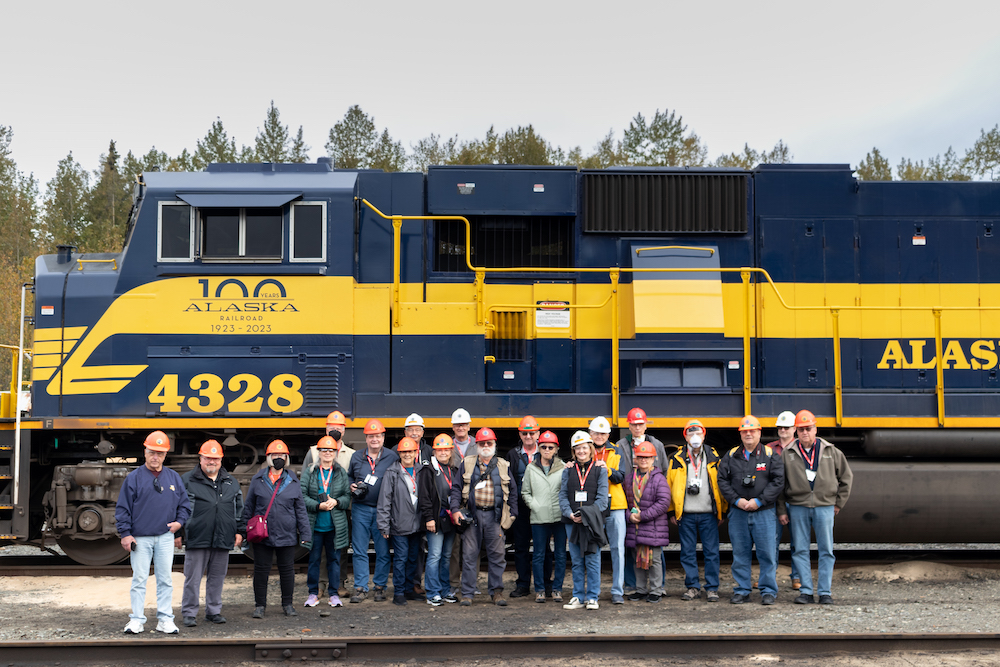
Day 1, Sunday 9/10 | Fairbanks
Depending on where you live, getting to Alaska can take a while. In my case, it meant waking in time to catch a 4 a.m. airport shuttle from Milwaukee to Chicago, a six-hour non-stop flight to Anchorage, and another hour in a regional jet to reach Fairbanks. It was a long day. I think that’s why, when I arrived in Alaska, I briefly wondered if American money was accepted. I was either jet-lagged or losing my marbles.
Fairbanks is in the middle of Alaska. It is the state’s second-largest city, but that doesn’t make it especially big. About 33,000 people call it home. Tour participants were met at baggage claim by our two coordinators from Special Interest Tours. They planned everything and did a fantastic job of keeping the tour moving smoothly.
I had a couple of hours to relax in my hotel room (in the downtown Marriott, across the street from the Dog Mushing Hall of Fame, and, no, I am not making that up). Then it was time to head downstairs and board the chartered bus that would accompany our tour and take care of non-rail transportation needs.
With the short drive to our welcome dinner, our nine-day Trains Magazine Alaska tour was officially underway.
In the coming days, we covered the Alaska Railroad main line from the northern end of track in Fairbanks to the southern end of the line at Resurrection Bay in Seward. Along the way, we made a few detours to experience more of the 49th State. The ARR is unusual. It’s a state-owned Class II operating both passenger and freight trains. Our 2023 tour marked the 100th anniversary of the ARR’s completion.
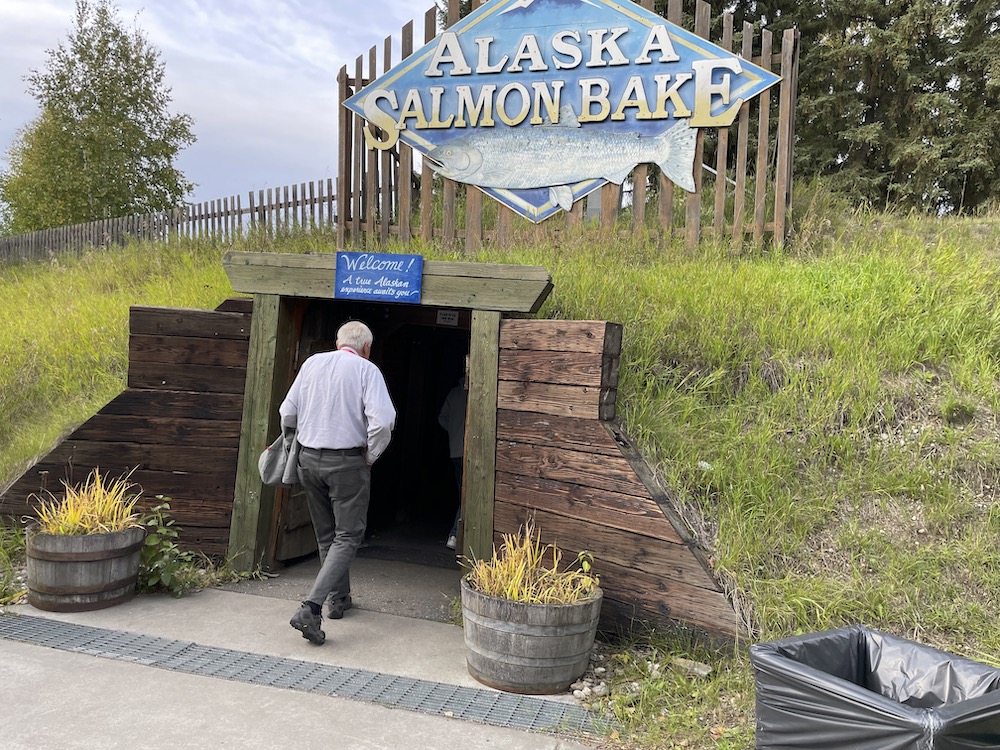
Our welcome dinner was held at the Alaska Salmon Bake at Fairbanks’ Pioneer Park. It’s surrounded by a grass-covered earthen berm and one enters through a mineshaft (a well-lit and extremely clean mineshaft … but still) to emerge in a beautiful grove of trees with many picnic tables.
It’s a nice setting but dinner is a bit complex. One collects a plate from the first shed, walks down a path to the next shed where the salad bar is located, then onward to select sides (mac and cheese, coleslaw, etc.) from the side shack, or whatever they call it, and further down the path to line up by a fire pit for a massive slab of grilled salmon (or prime rib or, in my case, breaded halibut) and, finally, a visit to the beverage barn.
The idea seems to be, why make do with one building when you can have six? Taking a seat at a picnic table with one of our travel coordinators, I said, “This is a goofy place.”
“I know!” she said enthusiastically, “Alaska is so weird!”
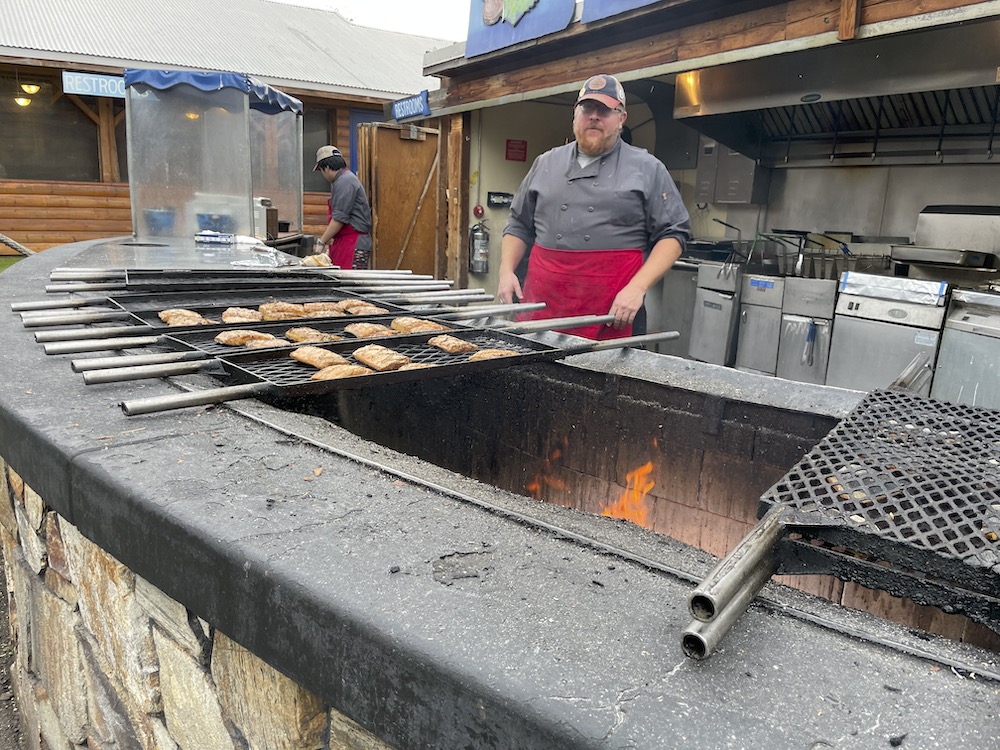
My halibut was very good. Talking to others on the tour I learned those who selected salmon, the specialty of the place, were generally unimpressed. Fish cooks fast over an open fire and the cooks were giving the fillets a little too much time in the flames. My advice? If you’re eating in Fairbanks’ Pioneer Park, go for the prime rib.
The driver of our chartered motorcoach was an interesting person. A retired airline pilot, bored and wanting to get out of the house, he had taken a job driving tour buses. For the coming week, he would shadow our group. He would drop us off at a train station in the morning, hustle down the highway to pick us up at another station in the evening, and shuttle us to our hotel then, perhaps, later driving us to a restaurant.
Heading back to our hotel after our dinner, our driver detoured to take us past the former Fairbanks passenger station, remodeled beyond all recognition, and the north end of the Alaska Railroad’s main line, which is also the northernmost railroad track in North America. (It ends behind the local newspaper’s office and there is a historical marker.)
Day 2, Monday 9/11 | Fairbanks to Denali National Park
Our bus arrived at 7 a.m. and we were off to the new Fairbanks depot to board ARR’s flagship train, the Denali Star. We rolled up to the train station just as boarding began. One of our group coordinators hurried inside and immediately returned with our tickets. This was a nice thing about Alaska: Trains, restaurants, and hotels are quite accustomed to dealing with tour groups and have it down to a science. Hotels had neatly organized stacks of room keys waiting for us, the restaurants had tables set aside, etc.
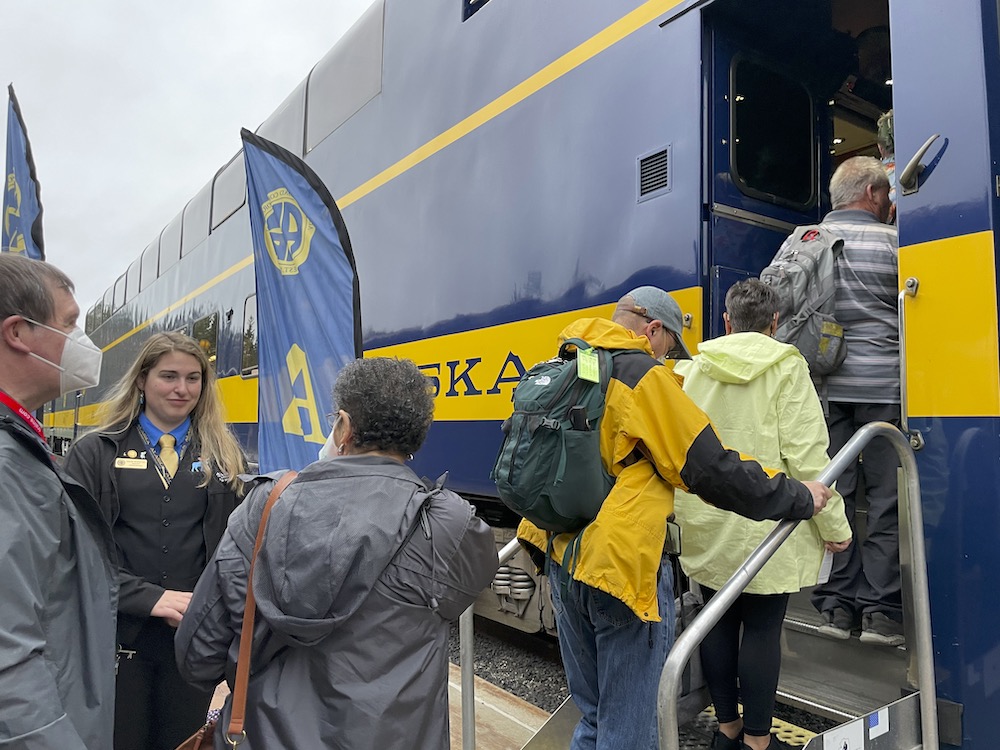
Tickets in hand we strolled through the lobby and right onto the train. (Our luggage stayed on the bus.) We would be riding in one of the custom-built 89-foot-long bilevel passenger cars the railroad dubs “GoldStar Service.” The lower level of each of these massive cars contains restrooms, a kitchen, and a full-service dining room, with all meals included in the fare. Upstairs are 78 reclining coach seats under panoramic windows and a staffed bar with complimentary beverages. At the very end of the car, sliding glass doors access an open-air deck. Made in 2005 by Colorado Railcar to Alaska Railroad’s design, the cars are smooth-riding and comfortable.
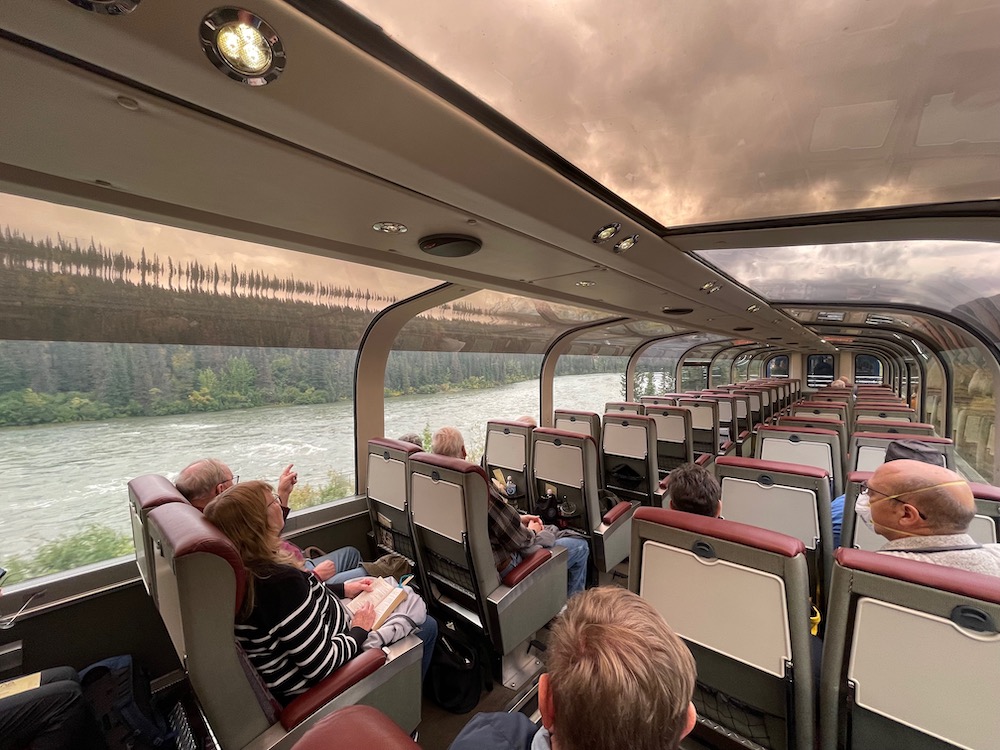
The Denali Star’s consist also includes single-level coaches and rebuilt classic dome cars, which provide the standard coach service the railroad dubs “Adventure Class.” Lower-level vestibules allow riders to walk the train if they wish.
We were soon rolling south behind a pair of SD70MACs, which make up the backbone of the railroad’s freight operations and also power ARR’s long-distance passenger trains.
During the summer months, ARR runs passenger trains during the day and freights at night. This gave the Denali Star smooth sailing down the single-track main but we weren’t the only thing moving. In addition to its own scheduled trains, Alaska RR operates passenger trains under contract for a couple of private operators.
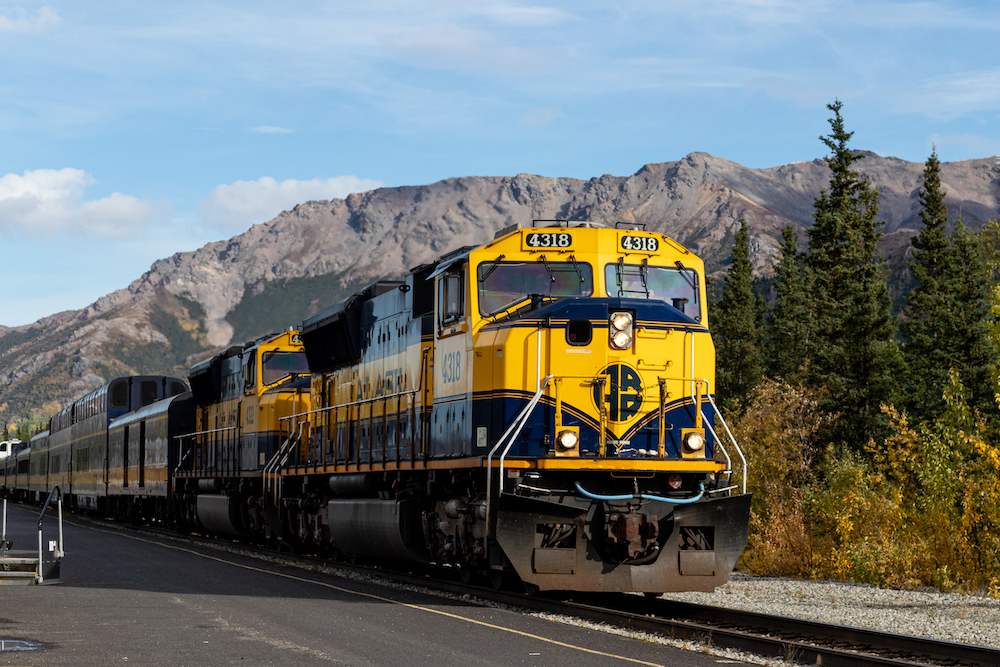
A few minutes past noon, our train pulled into the Denali National Park station. Train stations are uncommon in National Parks, but this one serves an important purpose. In 2021 the railroad delivered 59,861 park visitors, taking an estimated 14,500 motorcoaches off the lone two-lane highway that serves the park. We stepped off the train and right onto our waiting motorcoach to be driven a short distance to our hotel, where we were already checked in and our rooms ready.
After lunch in the hotel dining room, we had time to settle into our rooms, which had stunning views of the surrounding mountain range. It was a warm day and I spent a ridiculous amount of time on my room’s balcony just taking in the view.
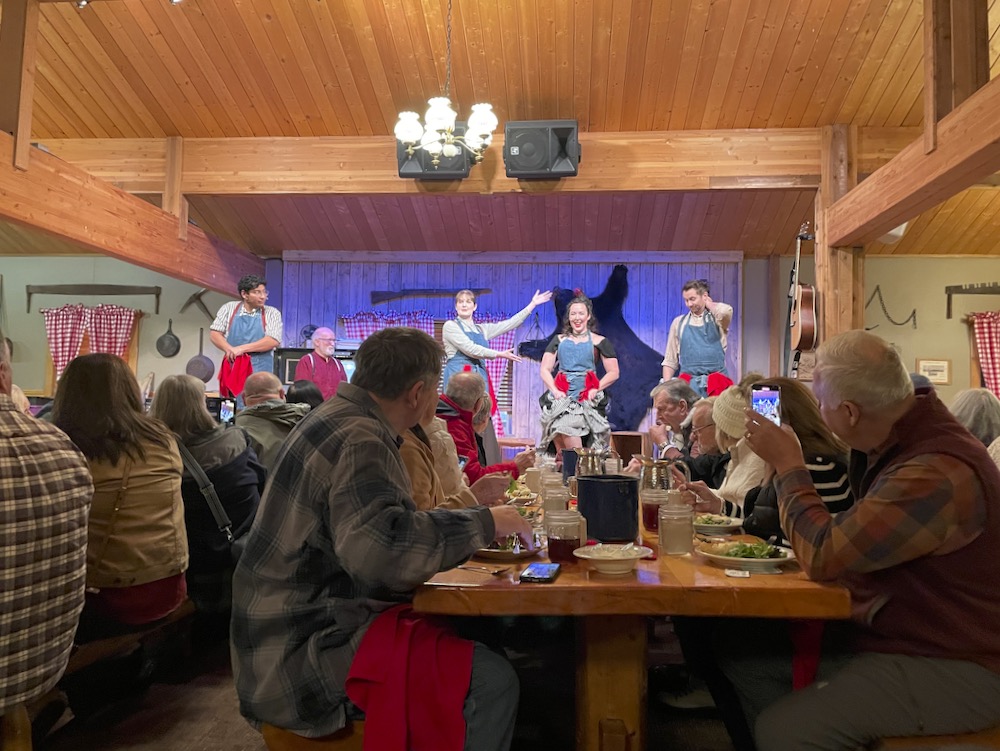
In the evening, we reboarded our bus for a visit to the Alaska Cabin Nite Dinner Theater. I’m not particularly a fan of dinner theater, but this one was excellent. The story revolves around real-life Fannie Quigley, a pioneer and cook who opened a primitive restaurant in this area in the early 1900s to feed gold prospectors. The dinner theater occupies a large log cabin, and the food is hearty and served family-style at wood tables. Fannie’s history, and those of her friends and neighbors who drop by, unfolds through storytelling, and energetic singing, and a great deal of humor. Save room for the berry cobbler!
Day 3, Tuesday 9/12 | Denali National Park
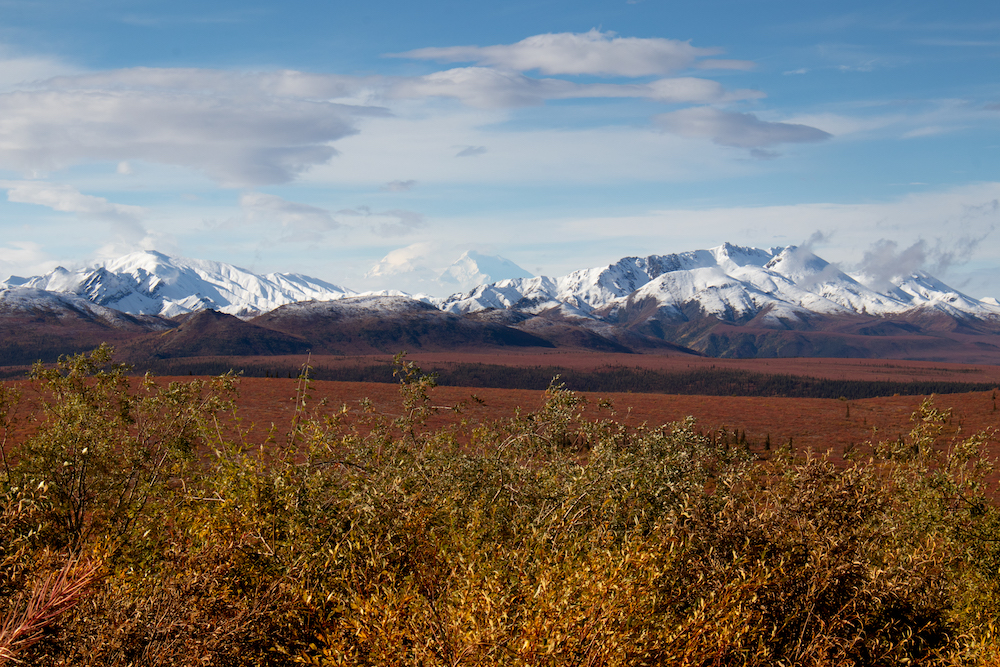
We were back on the move the next morning, but not by train. After breakfast, a Park Service bus driven by a certified interpretive guide picked us up at our hotel for a 5-hour narrated driving tour of the 9,492-square-mile Denali National Park (that’s bigger than New Hampshire). Since there’s only one road into the heart of the park and only Park Service buses are allowed, this is not only a great way to see Denali, it’s the only way.
Caribou and moose were sighted along with ptarmigan, Alaska’s state bird, and even a fleeting glimpse of a wolverine as we moved from dense forest to arctic tundra enjoying dramatic views of the mountain range that includes the park’s namesake peak, highest in North America. (Denali means “the great one, the big one.”) Seeing the peak was a treat. It’s so frequently shrouded in clouds that only about 30% of park visitors will see the mountain. Our guide said this was the first time in a month that one of her tours glimpsed the peak.
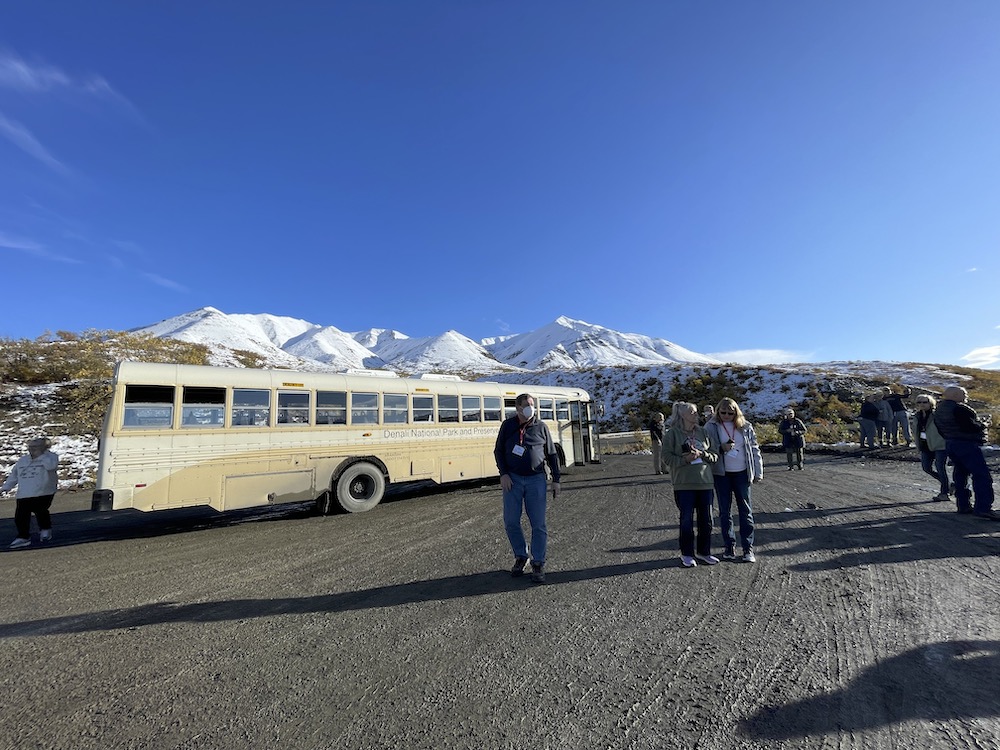
Our park bus delivered us back to our hotel in the early afternoon but I hadn’t gotten my fill of the park, so I hopped on the hotel’s free shuttle and spent the remainder of the day in Denali, checking out the nature center and photographing the northbound Denali Star.
With snow already moving down from the mountains, the park was scheduled to close for the season the following day. This also meant our hotel was closing until spring. As people checked out, crews moved in to winterize the now-vacant rooms. Although the weather remained comfortable, albeit rainy at times, winter was chasing us south. By the last day of our tour, we had an hour less daylight than we had on the first day. The Denali Star was also making its last runs, soon to be replaced by the weekends-only Aurora, which runs between Anchorage and Fairbanks during the winter months.
Day 4, Wednesday 9/13 | Denali to Talkeetna
We were waiting at the Denali Park train depot when the southbound Denali Star rolled in shortly after noon to take us on the next stage of our journey south. Ahead was a 5-hour ride in GoldStar class, climbing to the highest point on the ARR, the crossing of the Continental Divide at 2,363 feet. Once over the Alaska Range, we rolled sedately downhill and across the ARR’s longest and tallest bridge, which spans Hurricane Gulch (named for the occasional extreme winds encountered here), 296 feet below the tracks.
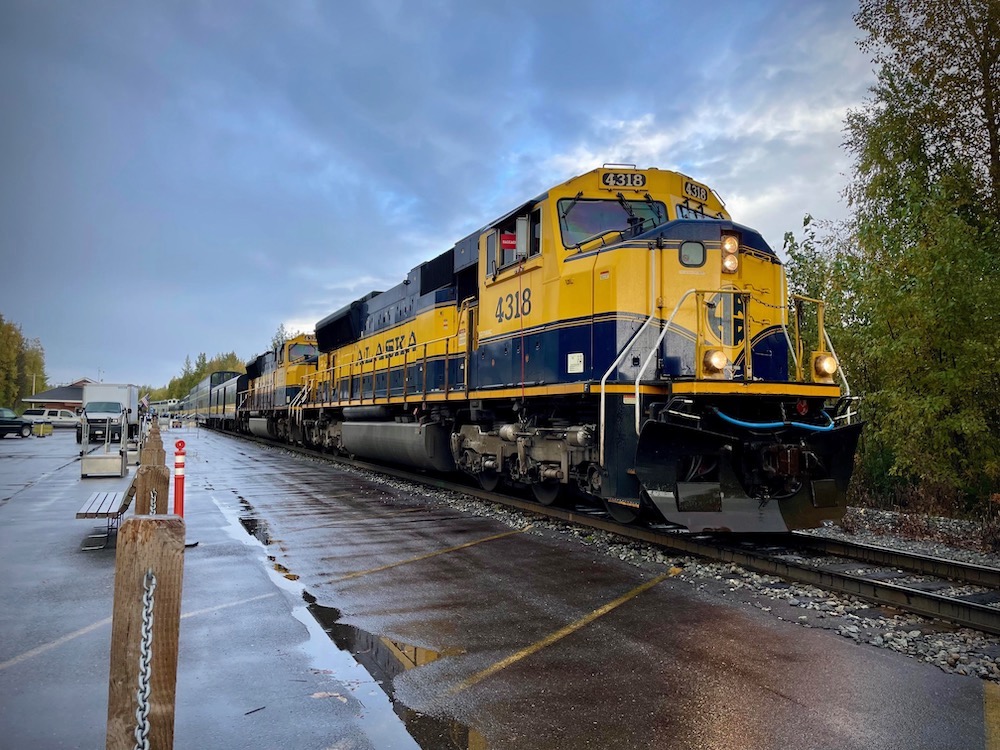
At 5 p.m., we disembarked in the former mining and fur-trapping town of Talkeetna, population just over a thousand, and were driven a short distance to our overnight stay in Talkeetna Alaskan Lodge.
The town of Talkeetna is best described as “quirky.” The fictional town in the television series “Northern Exposure” was inspired by this community’s offbeat character. For example, you can pay your respects at “The Tomb of the Unknown Hippie,” a memorial garden dedicated to both long-time residents and transients alike. Its website helpfully explains, “The Tomb of the Unknown Hippie was originally conceived in the 1980s after a night of drinking.”
Day 5, Thursday 9/14 | Talkeetna round trip—Hurricane Turn
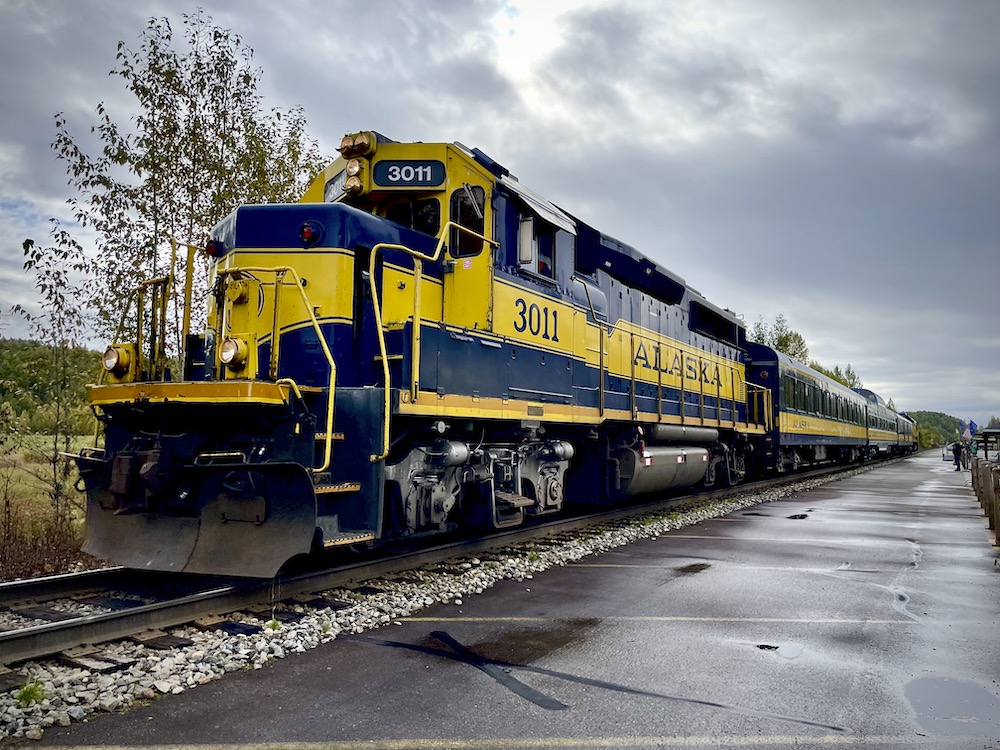
Today’s train ride was both more of the same but completely different.
Our motorcoach delivered us to Talkeetna’s depot, where we boarded the northbound Hurricane Turn. We would retrace our journey of the day before, all the way back to the train’s namesake bridge, then return to Talkeetna.
The Hurricane Turn is the last true flag-stop train remaining in North America and is the most laidback train I’ve encountered. There is a snack bar in the dome car that operates on the honor system, just take what you want and leave your payment in a box on the counter. Some passengers brought their dogs along. A 14-year-old going moose hunting with her father boarded with a high-powered rifle (borrowed from her mother) tucked under her arm. No one found this unusual.
The train stops here and there to pick up or drop off hunters and people living off the grid. We even halted for a few minutes to watch salmon spawning in a shallow gravel-bottomed stream next to the tracks. Remember, this is taking place on the ARR’s main line.
Alaska Railroad passenger trains have onboard car hosts who provide narration. The host on the Hurricane Turn was well-informed on many subjects, ranging from wildlife to the details of living off the grid. If you’ve ever used an outhouse at 40 below zero, she informed us earnestly, you would understand how much of a game-changer an indoor composting toilet can be.
She also mentioned we were about to take a siding and wait for a southbound passenger train, a meet routinely scheduled at this place. At this siding, the guide told us, deep in the wilderness, is the cabin and art studio of Shannon Cartwright, a well-known illustrator of dozens of children’s books, the combined print runs of these adding up to more than 2 million books. Visitors are welcome.
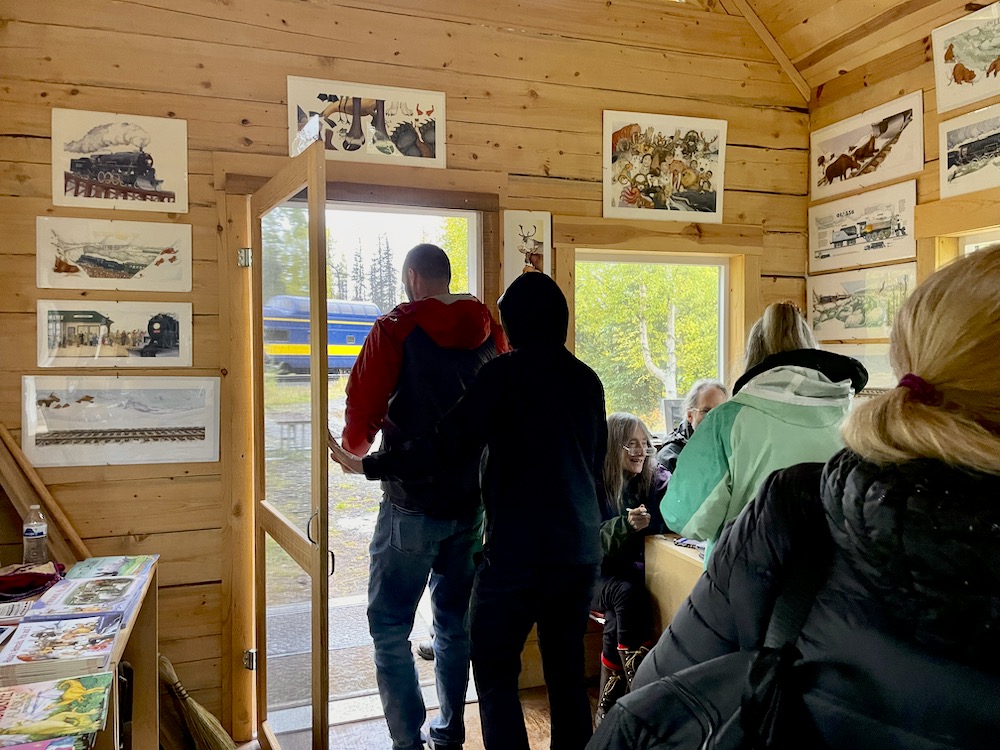
The train stopped, and I joined several members of our tour who braved the drizzle and puddles to visit what is certainly America’s most remote art gallery. I briefly worried the train might leave without us, but the conductor came along to make sure we didn’t go astray. (While we shopped, he fed treats to Cartwright’s huge and friendly dog.) The tiny gallery offers prints of her whimsical illustrations for sale, as well as many of her books. One lady commented, “I can’t believe how much art you’ve produced.” With a shy smile, Cartwright said, “Well, I have a lot of time.”
Then we splashed away to reboard our train and, with the day’s brief rush of business concluded, left her to her work.
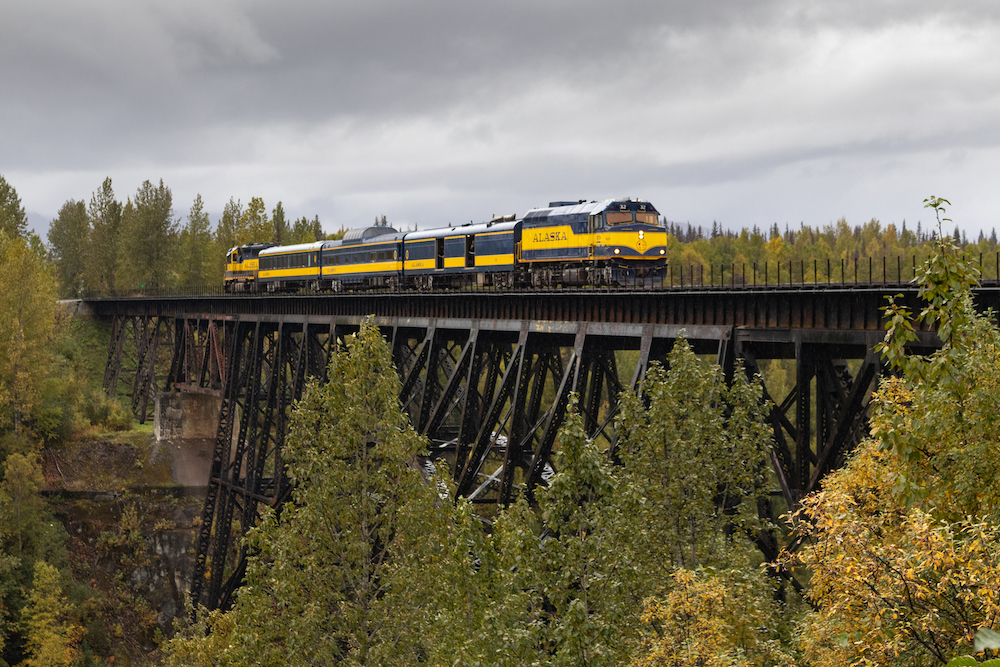
Our next stop was Hurricane Gulch. The train dropped me off short of the bridge to try for a photo as the train moved out to midspan to let passengers stand in the baggage car doors for a vertigo-inducing view of the river 300 feet below.
On the way back to Talkeetna, the train halted at an informal trackside park to let us stretch our legs. It’s a flat patch of ground bordered by a fast-moving creek with tall rock walls. Railroaders thought it made a nice picnic ground, so they built a fire ring and hauled in a picnic table. From time to time, people get off the northbound here, enjoy a picnic and a few hours of solitude in the wilderness, and are then picked up by the returning southbound. Why did we stop here? On the other hand, why not? It’s a different sort of railroading.
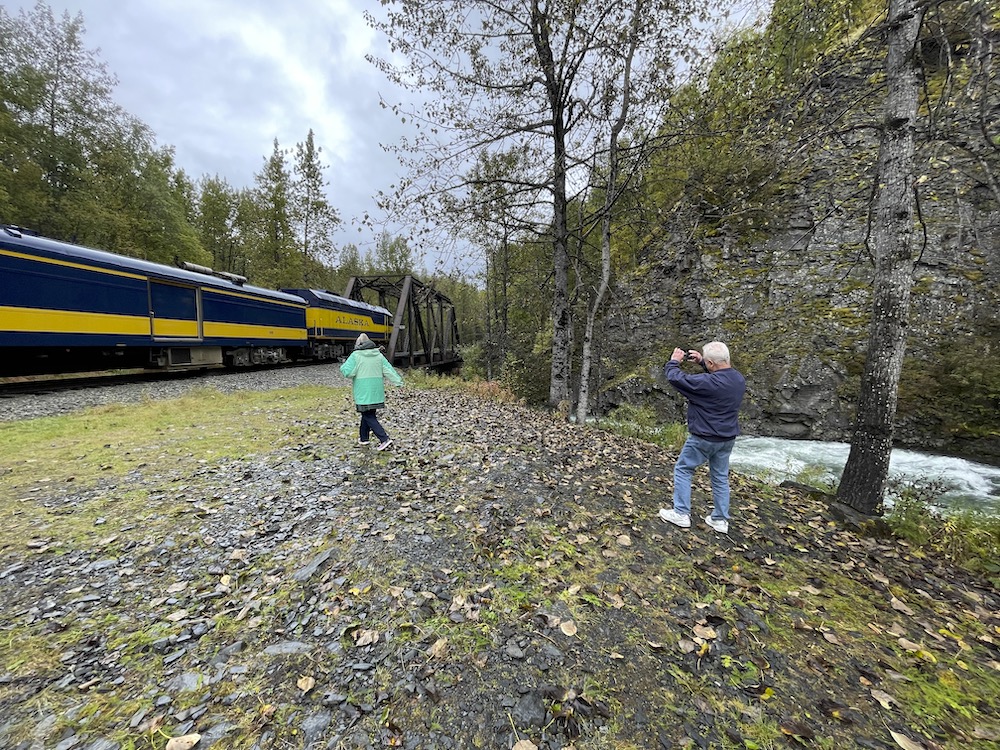
I greatly enjoyed my trip on the Hurricane Turn. It offered a look at an Alaska you can’t get from the plush and pampered confines of GoldStar class.
Day 6, Friday 9/15 | Talkeetna to Anchorage
Today we would board the Denali Star for the final leg into Anchorage, but since it rolls into Talkeetna at 5 p.m. we had time to explore the town. (For the adventurous, Talkeetna’s airport is a good place to book Denali flightseeing or a glacier landing tour for an extra charge.)
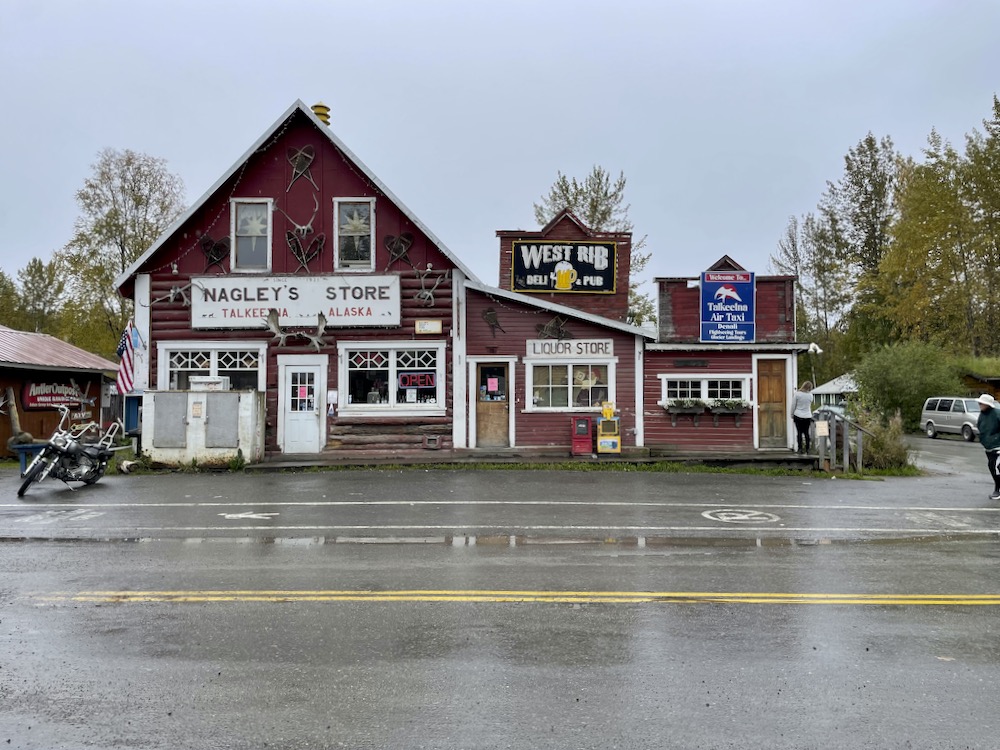
As for me, I walked around, pretty much at random, and stopped at the town’s store to buy a soft drink. While my purchase was being rung up, a couple entered and said, “We were hoping to see the mayor.”
The clerk pointed to a huge antique dogsled suspended from the rafters above our heads. “He’s sleeping in that. Just climb the stairs and look over the railing.”
Their conversation struck me as odd, but many things about Talkeetna struck me as odd.
I should have climbed those stairs myself because I missed one of Alaska’s best-known politicians. As an unincorporated community, Talkeetna doesn’t have an elected mayor. Instead, a cat living in the town’s store has held the post of honorary mayor for many years.
“You know, it is a very small neighborhood so I can’t imagine needing more than that,” resident Cris Vargis explained to Anchorage television station KTUU.
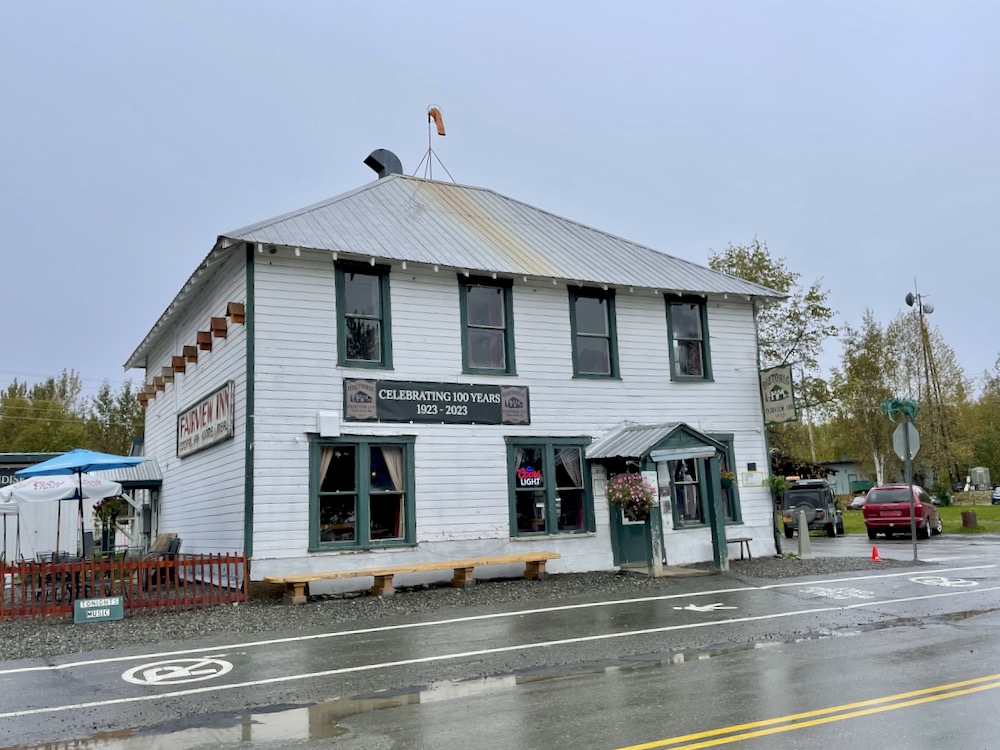
Across the street from the general store is the tavern and inn where President Warren Harding stayed when he visited the state to drive the ARR’s golden spike, 100 years ago. Some locals believe the president was fatally poisoned here. (Harding, suffering a mysterious illness, died in San Francisco on his return trip from Alaska.) Who would want him dead? Well, Harding was having an affair with his secretary, which the first lady knew about. After his passing, she refused to allow an autopsy and had him embalmed an hour after his death.
To be fair, Florence Kling Harding is an extremely unlikely suspect. So if you don’t believe the murder angle — and doubters include most historians — there’s also a theory Harding suffered food poisoning courtesy of the lobster meal he consumed at Talkeetna. Either way, the resident I spoke with was pretty sure the town killed him.
The train arrived and whisked us southward. We arrived in Anchorage at 8 p.m., where our trusty motorcoach was waiting to take us the few blocks to our downtown hotel. After the small towns and large swaths of wilderness, being in a large city again was a jarring transition.
Day 7, Saturday 9/16 | Anchorage – Engine 557 Shop Tour
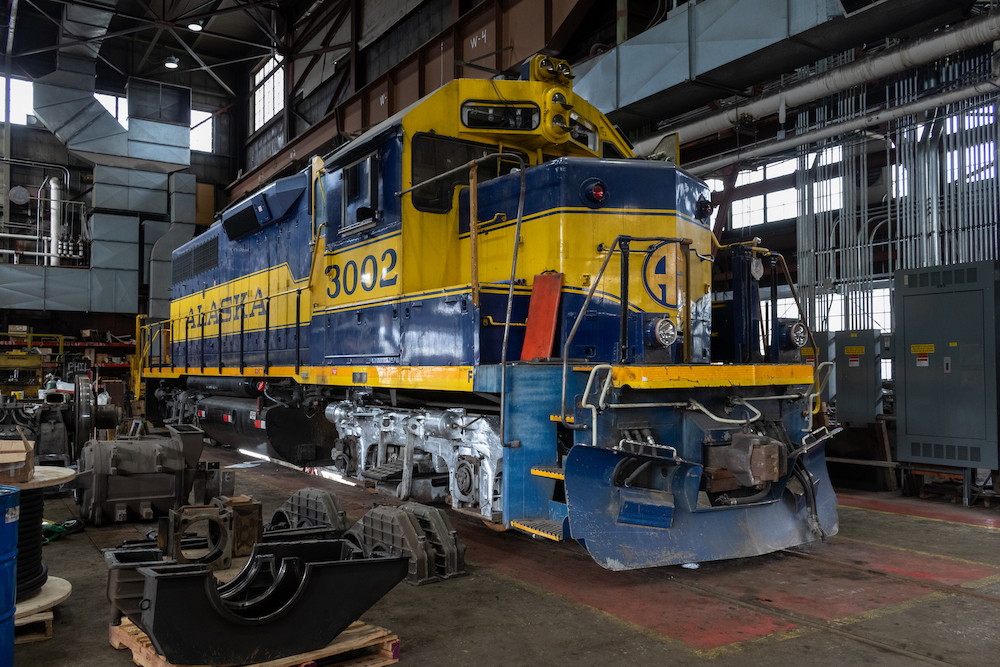
It was a day to look behind the scenes. In the morning, ARR employees welcomed the Trains’ Tour and showed us around the railroad’s massive Anchorage Shops. Impressive for its size and capabilities, the Shops perform nearly all needed repairs since components can’t practically be sent out to be rebuilt, given the state-owned line’s isolation from the nation’s rail network.
We also posed for a group photo with the ARR’s specially decorated SD70MAC commemorating the 100th anniversary of the railroad’s completion. The design is based on the early 1950s passenger paint scheme.
We reboarded our motor coach for a drive to Wasilla where the volunteers of the 557 Restoration Company treated us to lunch in the steam shop and a detailed briefing on their progress toward restoring 2-8-0 Consolidation No. 557 to operation. They knew how to win us over — good food and a steam engine!
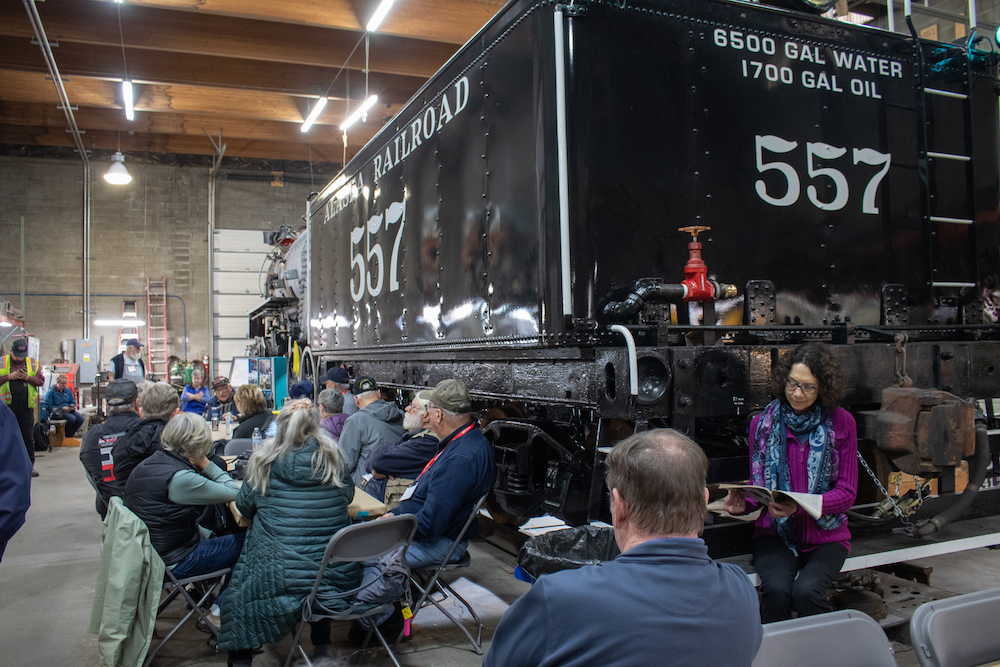
The 557 is part of the S160 class 2-8-0 locomotives built between 1942 and 1945 by Alco, Baldwin, and Lima for the United States Army Transportation Corps. The 2,120 locomotives built to this design represent the largest-ever single class of steam locomotives. Known as GI Consolidations, most served overseas but a dozen made their way to Alaska. Once restored, the 557 will be the only operating example of the once-numerous S160 class in the United States.
The determination of the group and the amount of local backing they’ve received is remarkable. Restoration work is going very well. When will we see it in steam? Their goal is “Ride in ’25”!
Day 8, Sunday 9/17 | Anchorage to Seward round trip
Our last full day in Alaska began before dawn with boarding of the Coastal Classic and a scenic 4-hour ride to the south end of the ARR in Seward highlighted by its long run alongside Turnagain Arm, where the steep mountains of the Chugach Range meet the sea, followed by a steeply winding climb into the heart of the mountains. It’s easy to see why National Geographic Traveler named the Coastal Classic one of the top 10 train rides in North America.
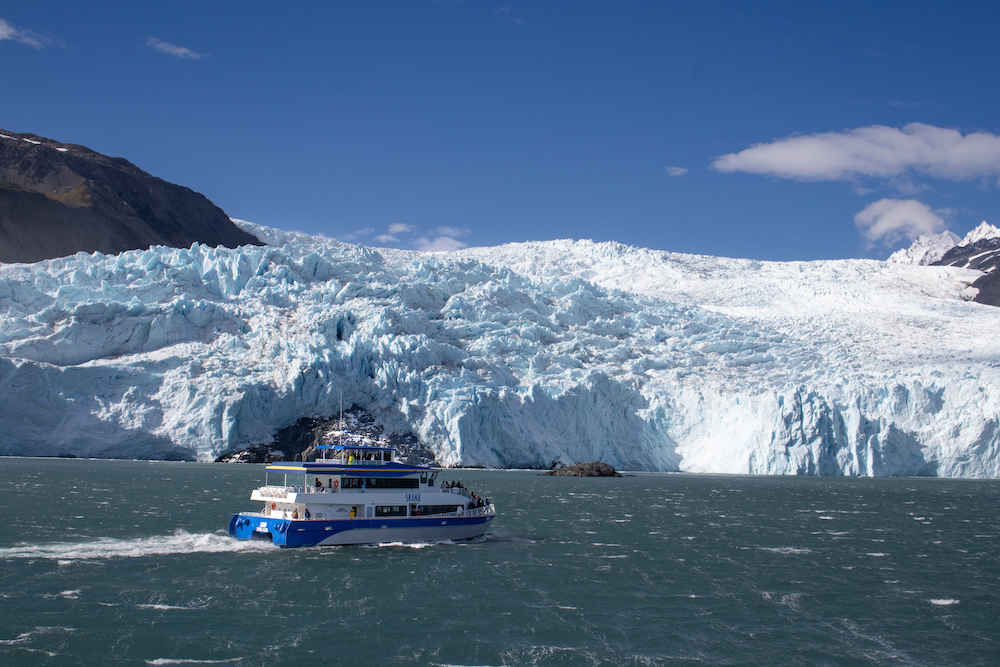
The Coastal Classic lays over in Seward for most of the day, giving our group time for a 6-hour cruise of Kenai Fjords National Park. The 1,000-square-mile park contains 40 glaciers flowing from the Harding Icefield, Its limited land access means a boat tour is the best way to see the sprawling park. It was a clear day, but windy and rough at times on the Gulf of Alaska.
The trip was narrated by the captain who noted at one point that our next landfall, should he maintain our current heading, would be Antarctica, making this one of the longest uninterrupted expanses of water on the planet. Instead, he took us on a 110-mile round trip to Kenai’s Holgate tidewater glacier. After all, we had an evening train to catch and, sad to realize, a morning flight back to the lower 48.
Associate Editor Bob Lettenberger leads the 2024 Trains Tour of Alaska in September 2024. Details of all our upcoming rail adventures can be found here.
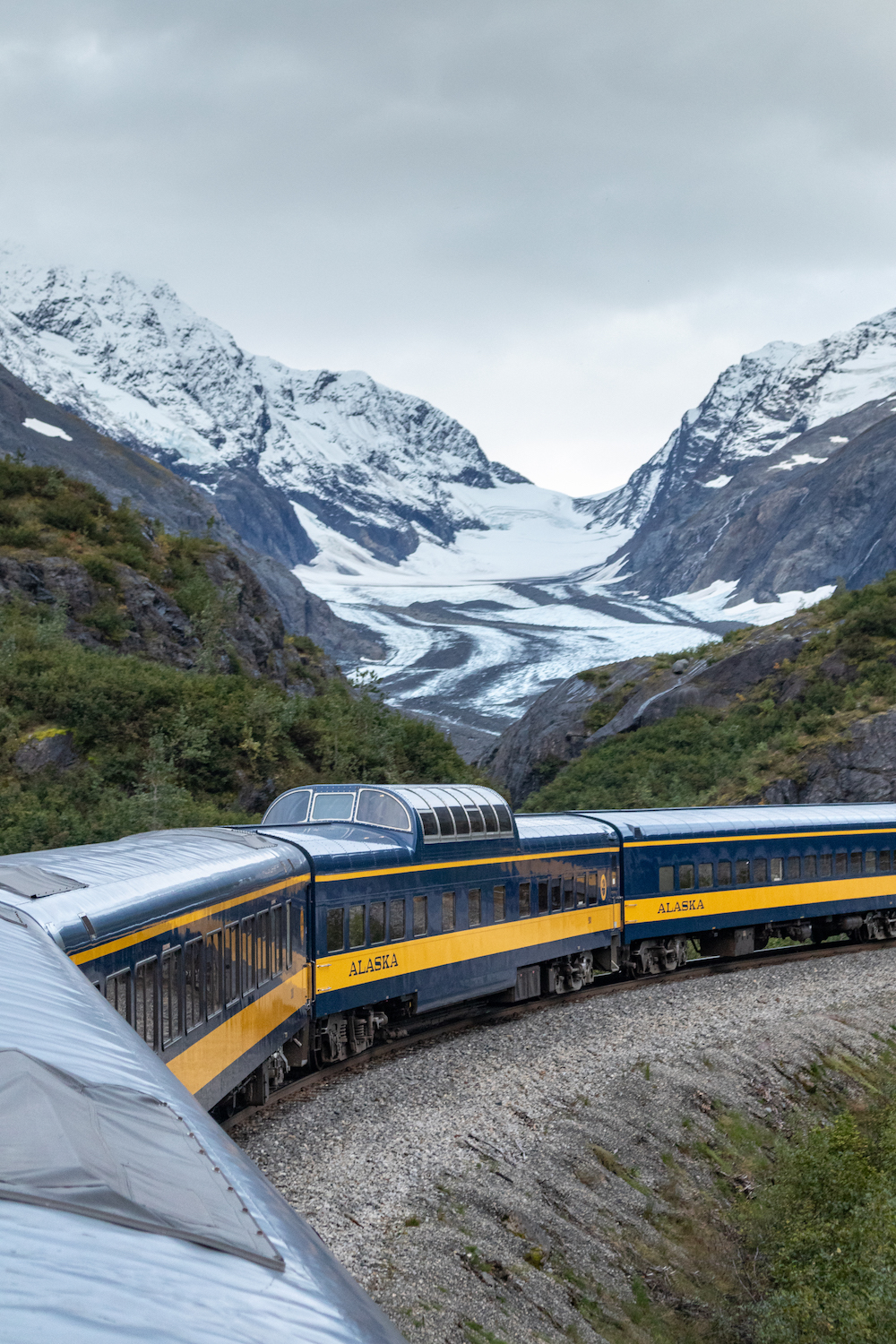






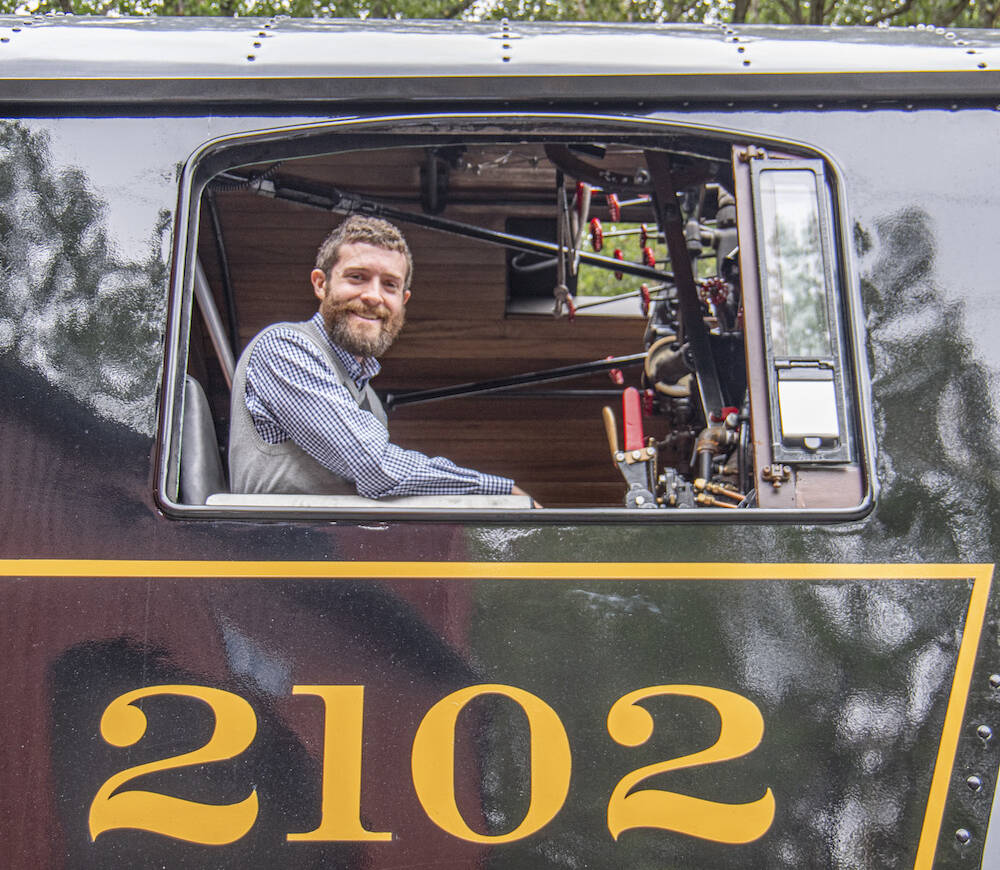
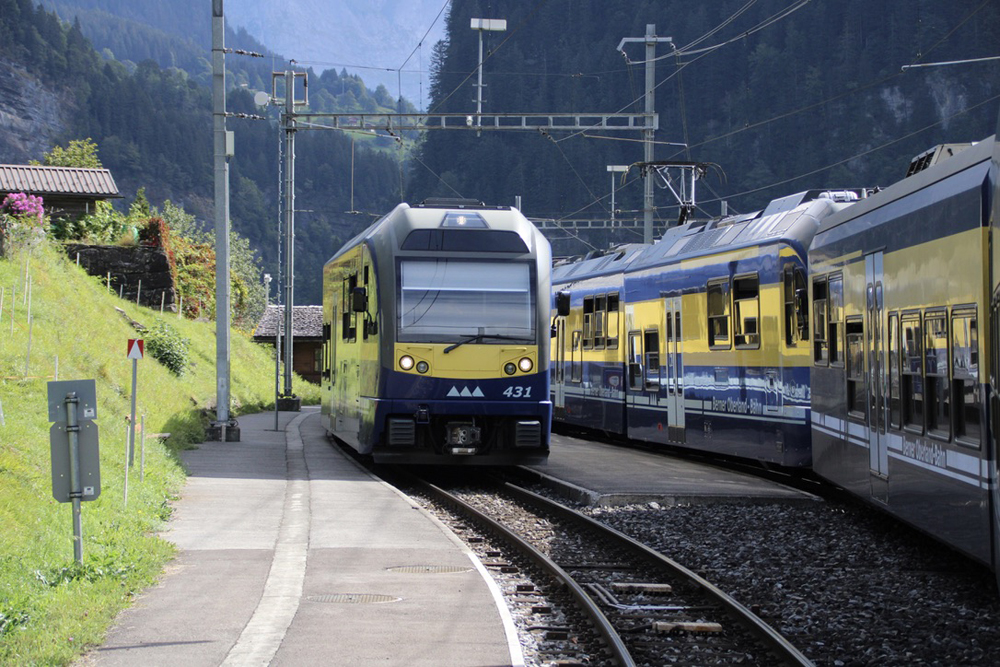
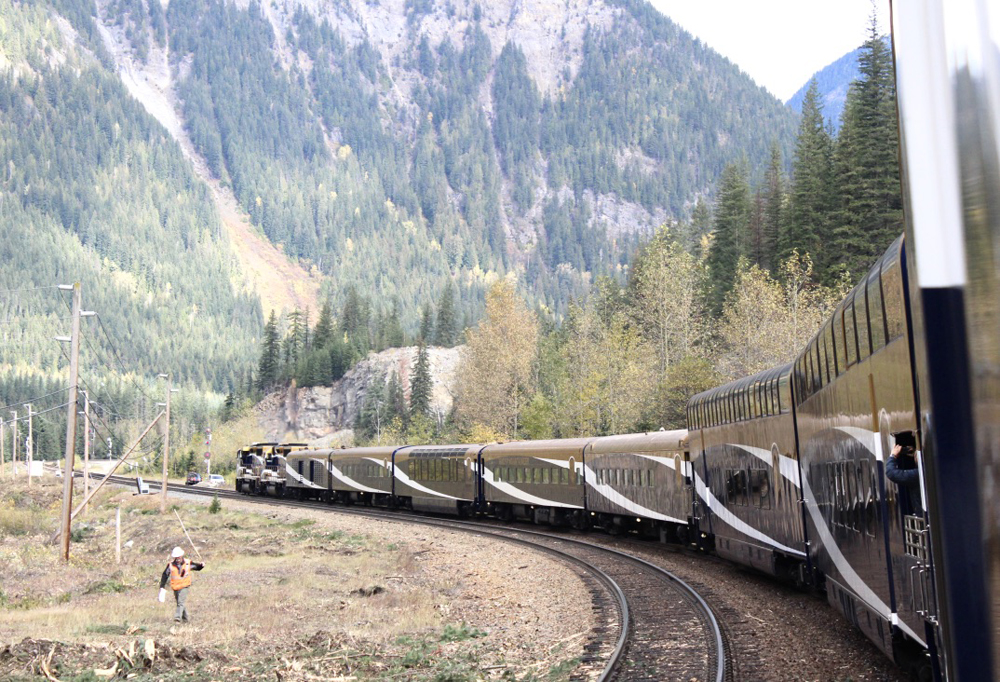
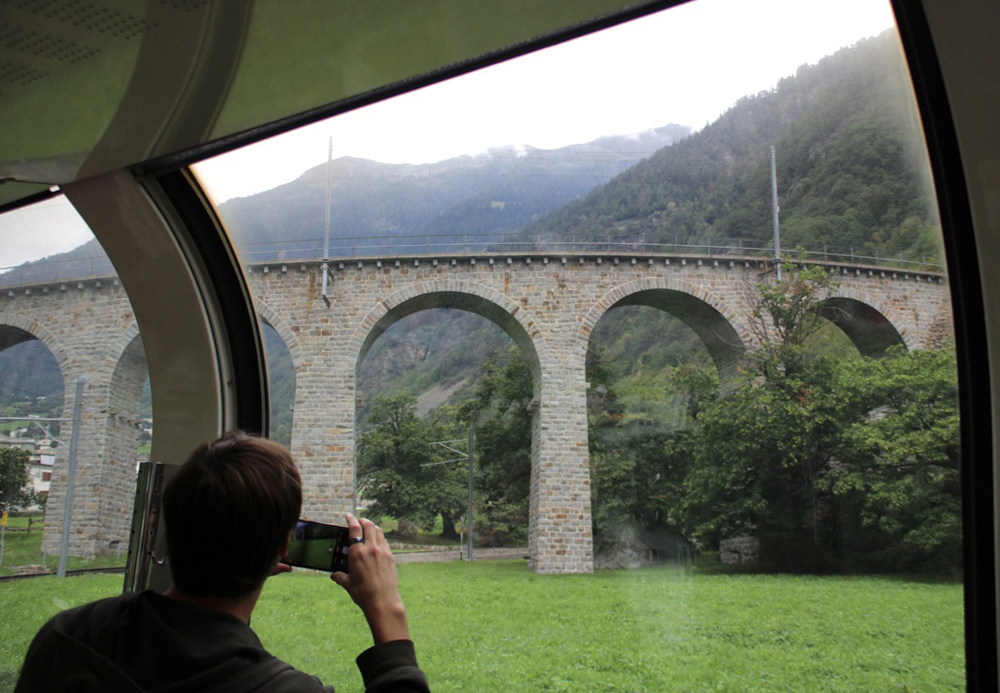




I enjoyed your story. Alaska is an awesome place that my wife and I have enjoyed on a 15 day sea and land cruise ending in Fairbanks. I tell everyone that Alaska should be in your bucket list.
I enjoyed all of the article. My experience is mostly a ride on the one car RDC Hurricane Turn, December 7, 1995. Great Smoky Mountain Railway also claims to run a member on the large class of GI Consolidations and I believe the U S Army steams one at Fort Eustis. Russia’s Class 0-10-0 of 1912 had 11,000 engines and Germany’s 1942 Kriegslok 2-10-0 had 7,000. GI engines had competition, but now they are preserved all over the world.
Glad you had a great time. Now you might understand why we lived just outside of Fairbanks for 20 years. Hopefully you looked in on the Tanana Valley Model Railroad Club layout while you were in the train station in Fairbanks. Nice article! Been to all those places, some on the train, some in our Suburban and a few in our airplane (wife is a pilot).
Fantastic article! I was in the Navy and we pulled into Seward, so of course I jumped on the train to Anchorage. Fantastic article, thanks!